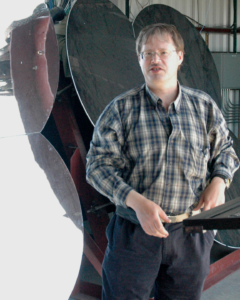Dear Friends of Chemistry:
 It has been a while since we published our last issue of the Catalyst. Many things have changed since then–we have new colleagues, lost some of our friends, weathered the complexity of the pandemic, and continued to build the department. What has remained the same is the underlying passion, drive, and excellence that I observe day to day in our faculty, staff, graduate and undergraduate students, and postdoctoral researchers. I see this while advising and mentoring my own research team and working with my colleagues and our staff to address challenges.
It has been a while since we published our last issue of the Catalyst. Many things have changed since then–we have new colleagues, lost some of our friends, weathered the complexity of the pandemic, and continued to build the department. What has remained the same is the underlying passion, drive, and excellence that I observe day to day in our faculty, staff, graduate and undergraduate students, and postdoctoral researchers. I see this while advising and mentoring my own research team and working with my colleagues and our staff to address challenges.
Perhaps the clearest view of our culture was on display in October as we recognized our four 2023 Distinguished Alumni Awardees
(who will be highlighted in detail in the next issue!). Their message to our current faculty and students was the same: you are providing and receiving an outstanding education that will allow you to lead the next generation of scientists, managers, and students. Their message was inspiring and a grand reminder of why we do what we do every day.
In this issue we feature the culture of our department and bring you up to date on several highlights from the last two years. This includes some descriptions of our successful alumni, including the 2020 Distinguished Alumni–Rik Tykwinski, Carrie Wager, and Raymond Price. In addition, a previous Chemistry Distinguished Alumnus, Clifton Sanders, has been recognized in several Universitywide honors, including the 2023 U
Distinguished Alumni Award and the 2023 Hugo Rossi Lectureship. Finally, we do a deep dive into one of our more recent graduates, Rory “Ziggy” Uibel and his adventures in growing a highly successful local instrument company.
The issue also highlights faculty and students who have received prominent recognition and have had exciting research accomplishments. While there are many to acknowledge, I would like to give a shout-out to Cindy Burrows (Pauling Medal), Valeria Molinero (Irving Langmuir Award and induction into the National Academy of Sciences), Michael Morse (Distinguished Professorship), and Luisa Whittaker -Brooks (U Presidential Scholar, ACS-WCC 2024 Rising Star Award, and MRS Outstanding Early Career Investigator Award). It is always rewarding to see our colleagues honored for their excellence!
On a sad note, we lost several of our former colleagues, including Laya Kesner, Frank Harris, and Wes Bentrude. I was personally close with Wes as he retired soon after I arrived but remained present for several years while I was building my program. He was such a kind and giving person with an easy smile and great sense of humor. I will also note that his research on understanding the reactivity of unusual radicals has circled into the mainstream many years after his initial publications. The organic chemistry community is utilizing his insights as the use of radicals has had a renaissance in recent years.
As a final note, this is my last year as department chair. This has been a demanding job, and I look forward to passing the reins to my successor. However, I can say with all honesty that working with such an incredible group of people has been a pleasure. The culture of our department–collaboration, excellence in education and science, and a good sense of humor–has been a centering force through the challenges encountered.
Sincerely,

Chair Matt Sigman
Read the full issue here






 It has been a while since we published our last issue of the Catalyst. Many things have changed since then–we have new colleagues, lost some of our friends, weathered the complexity of the pandemic, and continued to build the department. What has remained the same is the underlying passion, drive, and excellence that I observe day to day in our faculty, staff, graduate and undergraduate students, and postdoctoral researchers. I see this while advising and mentoring my own research team and working with my colleagues and our staff to address challenges.
It has been a while since we published our last issue of the Catalyst. Many things have changed since then–we have new colleagues, lost some of our friends, weathered the complexity of the pandemic, and continued to build the department. What has remained the same is the underlying passion, drive, and excellence that I observe day to day in our faculty, staff, graduate and undergraduate students, and postdoctoral researchers. I see this while advising and mentoring my own research team and working with my colleagues and our staff to address challenges.

 This kind of customer service is legendary in the sector and has garnered the loyalty of clients who also benefit from rent-to-own set-ups that would otherwise run them $500,000. Most clients see a return on investment within two-to-four months, says Uibel with a grin. From a modest shop of five employees beginning in 1993, Process Instruments has grown to a staff of 16 and currently boasts a share of 20% of all U.S. refineries and 6% of the worldwide market.
This kind of customer service is legendary in the sector and has garnered the loyalty of clients who also benefit from rent-to-own set-ups that would otherwise run them $500,000. Most clients see a return on investment within two-to-four months, says Uibel with a grin. From a modest shop of five employees beginning in 1993, Process Instruments has grown to a staff of 16 and currently boasts a share of 20% of all U.S. refineries and 6% of the worldwide market.

